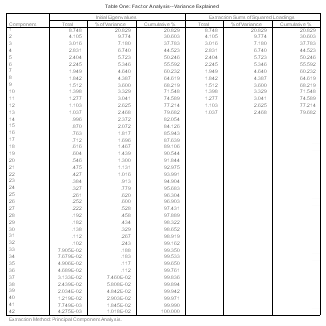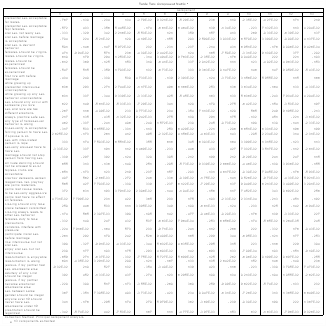
Possible Conflict in Human Sexuality Attitudes Between Males and Females at a Hispanic-Serving University: Factor Analysis of Sexual Attitudes
Russell Eisenman and M. L. Dantzker
University of Texas-Pan American
Author’s Note: Correspondence should be sent to Russell Eisenman, Ph.D., Department of Psychology, University of Texas-Pan American, Edinburg, TX 78541-2999, USA. E-mail: eisenman@panam.edu or to M. L. Dantzker, Ph.D., Department of Criminal Justice, University of Texas-Pan American, Edinburg, TX 78541-2999, USA. E-mail: mldantz@panam.edu.
Phone Russell Eisenman at 956 381-3327
FAX Russell Eisenman at 956 381-3333
Abstract
Several studies have been conducted by the authors on sex differences in human sexuality attitudes, between males and females at a Hispanic-serving university in deep South Texas. The present paper includes tables never before published of factor analysis of our attitude questionnaire, which, along with the other studies, suggests that these participants have both many sexuality attitudes in common and also differ in important ways, which could lead to conflict between the sexes.
Possible Conflict in Human Sexuality Attitudes Between Males and Females at a Hispanic-Serving University: Factor Analysis of Sexual Attitudes
We have been studying human sexuality attitudes among predominantly Hispanic college students. We have done the research at a Hispanic-serving university that is part of the University of Texas system. Located about 20 miles from the Mexican border, the University of Texas-Pan American in Edinburg, Texas has the largest number of Mexican-American students of any college in the United States (about 88% of the 14,000 students are Hispanic, most being Mexican-American), and the second largest number of Hispanic students, second only to Florida International University in Miami, Florida, which has many Cuban students. Our studies have shown much agreement in sexual attitudes, but with some sex differences as well (Dantzker & Eisenman, 2003a, 2003b; Eisenman & Dantzker, 2003, in press). Overall, males advocate more permissive sexual attitudes than females, but females have demands for sexual rights of their own (see especially Eisenman and Dantzker, in press). We originally devised a 42-item questionnaire, but dropped 4 items that failed to show sex differences or to survive a factor analysis, i. e., they fell in with no meaningful factors. So, our questionnaire now has 38-items.
In the factor analysis we did of a small sample of college students (Eisenman & Dantzker, in press), we were told by the editor to exclude the tables. So, we present the two tables here, Table 1 showing the variance explained by the factors, and Table 2 showing all the intercorrelations. Table 2 is a rich source of data, showing various intercorrelations, some of which did not contribute to any factor scales, but which may reveal important relationships. There were 68 usable questionnaires obtained, from 59 students who identified themselves as Hispanic, and 9 who identified themselves as non-Hispanic. Since the number of subjects was small for a factor analytic study, we look upon the results as preliminary.
More than any other study, the factor analytic study reveals differences between the males and females. The first factor, factor I (listed as Component 1 in Table l), is named permissiveness, and is present in many sex studies, although authors often do not appreciate it. It has to do with a general acceptance or rejection of sexual behaviors, i. e., a general liberal or conservative approach to sex. In the present study, females were more likely to be nonpermissive about sex than were males. The next two factors seem to be a factor of female privilege, factor II (listed as Component 2 in Table 1), and a factor of male privilege, factor III (listed as Component 3 in Table 1). In other words, after the permissiveness factor, the factor analysis reveals two strong factors that reflect the participants wanting rights for their sex—but not necessarily for the other sex. The woman want to ban Playboy and other materials, while having the right to have premarital sex. The males want the right to force sex on their mate, and, in general to have sexual freedom. The females seem to favor much sexual restrictiveness, especially on males. But, once they are sexually aroused, they say they must have sexual intercourse. This is true even thought the women say they were taught, growing up, that premarital sex is wrong.
It would appear that each sex has a gender consciousness for its own gender. Females want what they want, and males want what they want. This would seem likely to lead to conflicts between the sexes, as each strives to achieve their "rights" with possibly little regard for the rights of the opposite sex.
Thus, while the vast majority of our work shows mostly agreement between the sexes, the factor analysis in particular leads to a view of a battle between the sexes. Perhaps the small sex differences found in our other studies mask a latent misunderstanding between the sexes, which they mostly cover up.
While the number of non-Hispanic whites has been small in most of our samples, in one study we did have enough subjects to compare the two groups (Eisenman & Dantzker, 2003). We found the sexual attitudes on our questionnaire were essentially similar, with the Hispanics students, both male and female, being more conservative in their attitudes. We suspect that the strong influence of the Catholic church, which two-thirds of our Hispanic sample report belong to, influences them to take conservative sexual positions. In their behavior, there may be more extreme realities, but we cannot say for sure without data. But, attitudes and behavior do not always have to go together, as the first author found in an unpublished study of college students in Louisiana, where sexual attitudes were conservative but sexual behavior was liberal, i. e. permissive.
Further research should look at both agreement and disagreement in sex attitudes among Hispanics, and for Hispanic vs. non-Hispanic whites, etc. The area of sexual attitudes and sexual behavior is an important one for future investigation. A study at a university similar to ours found that Hispanic students often engaged in high-risk sexual behaviors, which has implications for sex research in general, and such issues as HIV/AIDS (Fierros-Gonzalez & Brown, 2002).


References
Dantzker, M. L., & Eisenman, R. (2003a). Sexual attitudes among Hispanic college students: Differences between males and females. International Journal of Adolescence and Youth, 11 79-89.
Dantzker, M. L, & Eisenman, R. (2003b). Sexual attitudes among Hispanic students at a border university: Gender differences and failure to support Buss’s jealousy theory. Manuscript submitted for publication.
Eisenman, R., & Dantzker, M. L. (2003). Gender and ethnic differences in sexual perceptions at a Hispanic-serving university, and failure to support Buss’ jealousy theory.
Manuscript submitted for publication.
Eisenman, R., & Dantzker, M. L. (in press). Permissiveness and male vs female privileges: Factor analysis of a sex attitudes scale. Journal of Evolutionary Psychology.
Fierros-Gonzalez, R., & Brown, J. M. (2002). High risk behaviors in a sample of Mexican-American college students. Psychological Reports, 90, 117-130.